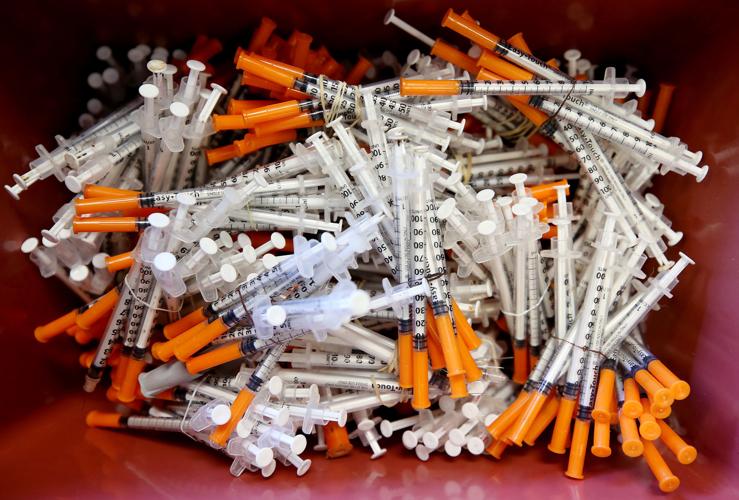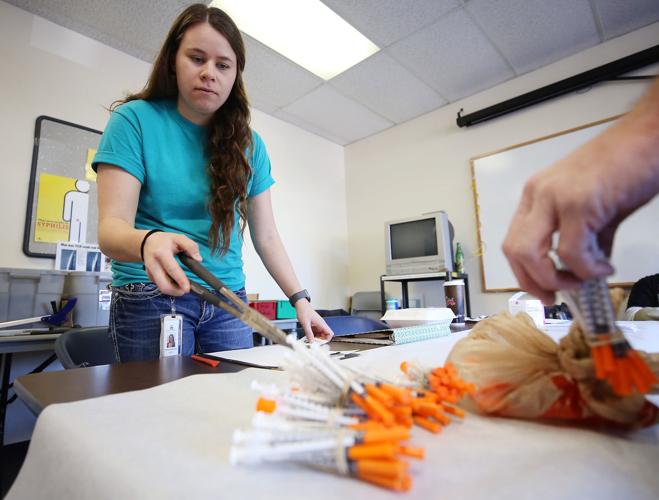The clients at Arizona’s only government-run needle exchange one recent Friday included a middle-aged man driving a minivan, a man in his 30s who came by bicycle on his way to work, and a 19-year-old woman who arrived on foot carrying a large plastic bag of belongings.
All inject illegal drugs and frequent the Tucson-based needle exchange to reduce their chances of getting wound infections and of contracting blood-borne diseases.
The exchanges, also known as syringe access or syringe exchange programs, aim to keep people safe by giving them a judgment-free way to get clean needles, leaders say. Advocates say people who use needle exchanges are also more likely to seek treatment.
Proposed legislation sponsored by state Rep. Tony Rivero, a Republican from Peoria, would authorize needle exchanges statewide. Supporters of the measure include the city of Tucson, the Arizona Public Health Association, the Arizona Medical Association, Mental Health America of Arizona and Pima County Attorney Barbara LaWall.
Legalizing needle exchanges is a step that 20 other states have taken, and one that advocates say was glaringly absent from Gov. Doug Ducey’s Arizona Opioid Epidemic Act, which was signed into law in January.
Not only do needle exchanges help prevent people who inject illegal drugs from getting diseases, advocates say, they also ensure the safe disposal of used needles.
Last year, Ducey declared a statewide health emergency due to the number of opioid overdose deaths in Arizona — about two per day in 2016.
Nearly 1,000 people have died of opioid-related causes in Arizona since June 15, and more than 600 Arizona babies have been born with possible drug-related withdrawal symptoms, state data shows.
Drug overdose deaths in Pima County have increased by 27 percent since 2010 (compared with population growth of about 2 percent) and 66 percent of the overdose deaths last year involved opioids, county data shows. Those who died ranged from four teenagers to three people in their 80’s.
Supporters say Rivero’s bill is a key step in addressing those numbers.
“There is a lot of lip service paid to the issues of substance abusing populations. This is something real and evidence-based that we should be supporting,” said Dr. Francisco Garcia, assistant Pima County administrator for health services. “We need to make sure these kinds of programs survive, and can come out of the shadows and serve more people.”
Evidence-based refers to programs shown to improve measurable outcomes.
Though it is technically a felony under Arizona law, Pima County’s LifePoint needle exchange program has been distributing needles to illegal drug users with the blessing of county officials and local law enforcement for more than 20 years.
Last year, the program distributed close to 200,000 clean needles, at no charge to the participants, during nearly 4,000 client visits. Most program participants are using heroin, county numbers show.
The Pima County program paved the way for the Southern Arizona AIDS Foundation (SAAF) to operate its own needle exchange program four years ago, though that program is at risk of closing because of funding problems.
Legalizing needle exchanges would add legitimacy to existing programs like LifePoint and an extra layer of protection for the people who use them, advocates say.
Additionally, state authorization would open up the possibility of public funding sources for new and existing needle exchanges like SAAF’s, which now must rely solely on private donations.
Pima County’s LifePoint program is the only needle exchange in Arizona currently funded with government money — about $45,000 per year.
The Arizona House of Representatives has already approved Rivero’s bill. It is scheduled to be heard by the Senate’s government committee on Wednesday.
“Harm reduction”
When the measure was passed on an 8-1 vote by the House Health Committee in February, the only opposition came from Rep. Jay Lawrence, a Republican from Scottsdale who said replacing needles on a continuing basis “merely encourages them to continue using illegal drugs,” though numerous studies have shown that to be untrue.
Advocates of decriminalizing needle exchanges lobbied unsuccessfully to have them included in the Arizona Department of Health Services’ Opioid Action Plan, released in September. The provision was also left out of Ducey’s subsequent Arizona Opioid Epidemic Act.
Governor’s spokesman Patrick Ptak said the reason syringe access programs were not included is that they do not “directly reduce opioid-related overdoses or deaths.”
Ptak would not say last week whether Ducey supports syringe access/needle exchange programs. He said the governor’s office does not comment on pending legislation. “The governor will review HB 2389 if and when it reaches his desk,” he said.
Maricopa County Attorney Bill Montgomery believes needle exchanges are “only trying to treat a symptom of drug addiction,” rather than focusing efforts to reduce and end addiction, spokeswoman Amanda Jacinto wrote in an email. Montgomery thinks the best approach is to focus on prevention first, she wrote.
But Pima County’s Garcia said needle exchange programs are a proven form of disease prevention. Needle exchanges are what’s known as a “harm reduction” strategy — a practical approach that aims to reduce the harmful effects of illegal drug use rather than ignoring or condemning the behavior, he said.
They are also an access point for getting health services to vulnerable people “who are impacted by the opioid epidemic, and also by poverty and economic hardship,” said Haley Coles, executive director of Sonoran Prevention Works. The group aims to end health disparities faced by Arizonans who use drugs and engage in other high-risk behaviors.
“We’ve talked with local law enforcement all over the state and generally they are supportive. They don’t want to interfere in these programs. But a lot of these programs can’t get money without the law changing.”
Coles estimates about 30 states have laws that allow needle exchanges. In addition to the states that explicitly decriminalized them, some permit them through an exemption in their drug paraphernalia laws. Others have local laws allowing them in certain jurisdictions, she said.
“I used to work at a program in Tacoma, Washington, and the state department of health would buy us all of our needles every year,” Coles said. “California does the same. New Mexico has a mandate that each of its health departments must operate a syringe access program.”
And while Arizona has touted itself as taking swift action against opioid-related deaths, the state was one of the last in the country to expand access to the emergency medication naloxone for opioid overdose reversals, and also one of the last to pass a “Good Samaritan” law that encourages people to call 911 in an overdose situation, she said.
Proponents say the cost savings from legalized needle exchanges are enormous. A new syringe costs 7 cents. By comparison, treating someone with hepatitis C or HIV will cost tens of thousands of dollars, said Christopher Thomas, a senior health education specialist at SAAF.
“If people don’t care about saving lives, there is a cold, hard financial argument,” he said.
South Tucson roots
The LifePoint program began in the city of South Tucson in 1996 in response to an increasing number of syringes being found in the area, sometimes still containing blood and heroin.
“It was a tough decision for us,” then South Tucson Police Chief Gerald Brewer told the Star in 1997. “We’re not condoning drug use.”
The Pima County Health Department collaborated with COPE Community Services and a grant from the Community Foundation of Arizona to start the program, which became Arizona’s first needle exchange.
LifePoint until recently provided services in three locations via a mobile van. But van mechanical problems mean LifePoint is now operating for six hours every Friday out of clinic space about four miles north of downtown Tucson.
The SAAF needle exchange operates from 4 to 7 p.m. three days per week.
The friendly banter and compassion of volunteers at the SAAF needle exchange made a huge difference for 36-year-old Desiree Voshefsky while she was struggling with an addiction to methamphetamine.
Voshefsky first heard about the SAAF program from friends and was initially suspicious it was a setup. But she went because she knew several people infected with Hepatitis C and she wanted to protect herself.
Once she started getting clean needles at SAAF, Voshefsky started using SAAF’s free testing services to make sure she didn’t have HIV or hepatitis C.
“When you go in you feel like an equal. They actually care,” said Voshefsky, who has been clean for nearly eight months and now volunteers at SAAF.
She is now enrolled in Pima County Superior Court’s drug court program, is working as a cashier, finishing her bachelor’s degree, and wants to become a recovery support specialist.
She also keeps naloxone she received from the program just in case. Since she’s struggled with addiction issues since age 18, there is always the risk of a relapse.
The SAAF program has distributed 2,423 naloxone overdose reversal kits to 1,746 people. One hundred and two overdose reversals have been reported to SAAF as a result of the kits, Thomas said.
Since money from private sources is usually for program startup costs, SAAF is having financial trouble trying to sustain its needle exchange program, Thomas said. The program will need an immediate infusion of money to avoid closure, he said.
“It took a long time to get trust with this population,” he said. “It would be very sad to see the program go away. It is really starting to bear fruit.”
“God bless”
On a recent Friday, county HIV program coordinator Miguel Soto sat in the LifePoint clinic along with health department educator Katherine Welchlin and COPE education specialist Isaac Durgin.
A steady stream of people came in, exchanging dirty needles for clean ones, bundling them with rubber bands into groups of 10. Most were returning clients.
The clients got other supplies from the county program, too, including Band-Aids, cotton, alcohol wipes, tourniquets, matches, tin cookers and antibiotic ointment. Some also picked up information about counseling, domestic violence and food banks.
The program has a base cost of $24,000 to $30,000 per year to purchase syringes. Other supplies can add an additional $15,000 a year.
Soto has worked at LifePoint on and off since 2000 and has an easy rapport with the clients. Trust is important, as is supporting and respecting the people who use the program, he said.
The average age of the participants is 40, and only 6 percent are under the age of 25. Nearly 70 percent are male, most are white and 18 percent are homeless, the program’s data shows.
Back in 2000, there was a higher percentage of people living on the streets, Soto said. “Now it could be anyone — artists, musicians, people working different jobs,” Soto said.
A friendly 23-year-old man who lost his leg because of a blood infection from injecting heroin came into LifePoint in a wheelchair. The man, who is unemployed, said he started using drugs at age 13. His mother was using drugs, too, he said.
He asked about where to get free food and Soto directed him to some resources.
A 19-year-old woman walked into the clinic shortly before noon. Wearing yoga pants, a tank top and a ball cap, she carried a large plastic bag and pulled out a wallet holding 11 dirty needles. She traded them for 11 clean ones and responded “yes” when Welchlin asked whether she needed any supplies.
“Cotton, Band-Aids, alcohol wipes and Neosporin,” the young woman said.
She slowly packed up her bag.
“God bless you guys,” she said as she left the clinic.





